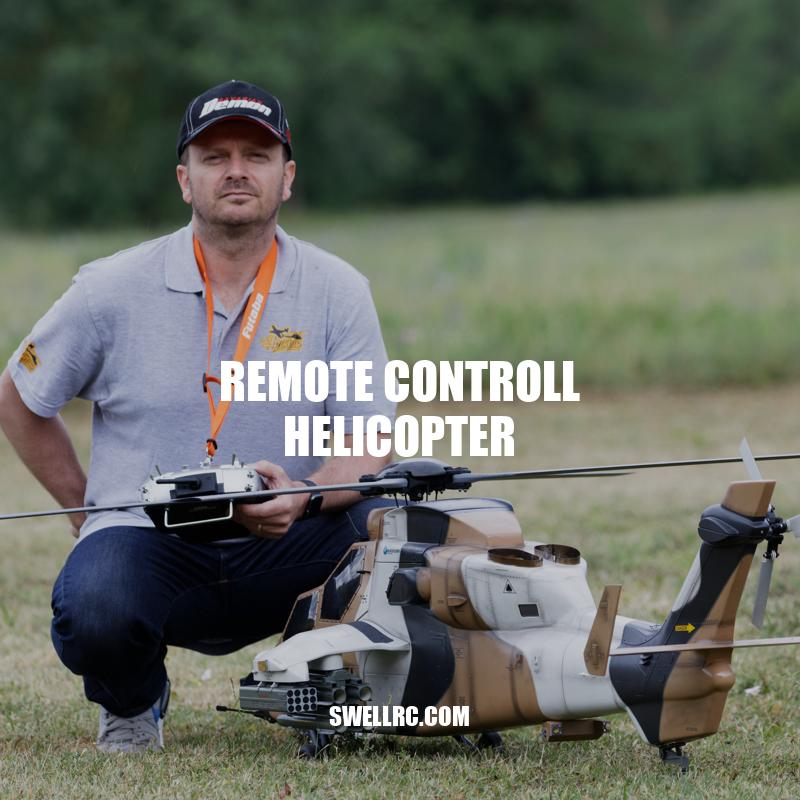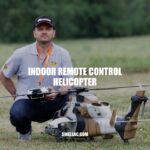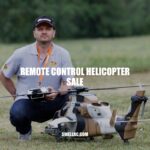Remote Controlled Helicopters: A Beginner’s Guide
Remote-controlled helicopters, also known as RC helicopters, are miniature flying machines that can be controlled using a remote control. They have been around for decades, and as technology has advanced, so have the capabilities and features of these airborne toys. Today, remote-controlled helicopters come in different sizes, shapes, and designs. They can be flown indoors or outdoors, and they offer endless hours of entertainment for pilots and their audiences. Flying an RC helicopter takes skill and patience, mainly because it requires mastering the art of hand-eye coordination. If you’re interested in exploring this engaging pastime, this article will guide you through the basics of how RC helicopters work, their different types and features, how to choose one that meets your needs and budget, and what safety precautions to take when flying them. Whether you are a novice or an experienced RC pilot, this article will provide you with insights and tips to improve your flying experience and avoid common pitfalls that can ruin your fun.
Different types of RC Helicopters
There are two main types of remote-controlled helicopters: toy-grade and hobby-grade. Below are the main differences between these types:
Toy-grade helicopters:
- Inexpensive and readily available in most toy stores
- Made of lightweight materials, such as plastic and foam
- Typically smaller in size and simpler in design
- Easy to assemble and operate
- Less powerful and have fewer features than hobby-grade models
Hobby-grade helicopters:
- Designed for experienced RC enthusiasts and hobbyists
- Made of higher quality materials, such as aluminum and carbon fiber
- More complex in design and construction, with many customizable features
- Offer a more realistic flying experience and better performance
- Can be expensive, with prices ranging from a few hundred to a few thousand dollars
- Require more skill and time to fly and maintain properly
When choosing between toy-grade and hobby-grade RC helicopters, consider your experience level, intended use, and budget. If you’re just starting out or looking for a fun gift for a child, a toy-grade helicopter can be a good option. However, if you want a more advanced and challenging flying experience, or you plan to invest more time and money into this hobby, a hobby-grade model may be a better choice. You can find a wide selection of both types of helicopters on websites like Amazon, HobbyKing, and Banggood.
What is the difference between toy grade and hobby grade RC?
- Toy Grade RC: These RCs are mostly found in departmental stores or toy stores. They are inexpensive, come with limited functionalities, and mostly targeted at children. Toy grade RCs are made from low-quality materials and break easily. They are not designed for customization and do not provide much scope for repair.
- Hobby Grade RC: These RCs are advanced, providing high-quality performance with greater flexibility for customization. Hobby grade RCs are made with high-quality materials and are designed for durability. They come with larger batteries and higher speed capabilities. These RCs can be repaired and upgraded with various parts available on hobby websites such as Horizon Hobby or AMain Hobbies.
If you’re looking for a reliable and high-performance hobby grade RC, make sure to research and purchase from established hobby websites or manufacturers such as Traxxas, Axial, and Redcat Racing.
Design and construction of RC Helicopters
Remote-controlled helicopters have a complex design and are made up of various parts that work together to ensure a smooth flying experience. Below are the four basic parts of an RC helicopter:
- Rotor System: Comprised of the main rotor and tail rotor blades which create lift and stability when spinning
- Control System: Includes the servos, which help control the movement of the rotor blades, and the gyro, which stabilizes the helicopter during flight
- Tail Boom: The long, thin shaft that connects the rotor system to the power system
- Power System: Includes the electric motor, battery, and speed controller, which provides the necessary power to lift and fly the helicopter
There are also additional components that contribute to the helicopter’s function and performance, such as the landing gear, frame, and body, which can affect the helicopter’s weight, balance, and durability.
It is important to note that the design and construction of different RC helicopters vary greatly based on their type, size, and purpose. For example, some helicopters may have a single rotor with no tail rotor while others may have dual rotors. Some may also have more advanced features like GPS and FPV (first-person view) technology.
If you’re interested in learning more about the design and operation of remote-controlled helicopters, there are many online resources available, such as forums, blogs, and tutorial videos on websites like RCGroups, RC Universe, and YouTube.
What are the parts of a RC helicopter?
A remote control (RC) helicopter consists of several parts that work together to help it fly. The main components of an RC helicopter include:
- Rotors: The rotors consist of the main rotor and tail rotor that spin in opposite directions to provide lift, direction, and stability to the helicopter.
- Body: The body or frame of the helicopter is the main structure that holds all the parts together.
- Motor: The motor powers the rotors and generates lift while in flight.
- Battery: The battery provides power to the motor and other electronic components of the helicopter.
- Transmitter: The transmitter is the handheld device used to control the helicopter’s movement and flight.
- Receiver: The receiver is located inside the helicopter and communicates with the transmitter to execute commands.
Understanding the different parts of an RC helicopter can help you choose the right model and accessories for your needs. For more information and a range of products, check out websites such as Horizon Hobby or Blade helicopters.
Flying and Control of RC Helicopters
The remote control plays a vital role in the flying and control of an RC helicopter. Here are some key functions and controls of the remote:
- The throttle controls the height of the helicopter
- The pitch control adjusts the angle of the rotor blades, which helps control the helicopter’s forward and backward movements
- The yaw control rotates the helicopter clockwise or counterclockwise around its vertical axis
- The roll control tilts the helicopter to the left or right, controlling its lateral movements
To fly an RC helicopter, it is important to understand how these controls work together in conjunction with the rotor system and other components. It takes time and practice to master these controls and become a skilled RC pilot.
When flying an RC helicopter, it is important to use caution and follow safety guidelines to avoid damage or injury. Some general safety precautions include:
- Choose an open, clear space to fly the helicopter
- Stay away from trees, buildings, and power lines
- Make sure no one is standing too close while you’re operating the helicopter
- Follow the manufacturer’s instructions for battery storage and charging
There are many online resources available to help new pilots learn how to fly and control their RC helicopter safely and effectively, such as video tutorials on RC Helicopter Fun and RC Academy, as well as forums and discussion groups on websites like Helifreak and RC Universe.
What are the controls of RC helicopter?
Here are the basic controls of an RC helicopter:
- Throttle Control: This controls the altitude and speed of the helicopter.
- Pitch Control: This controls the direction and angle of the rotor blades.
- Yaw Control: This controls the left and right movement of the helicopter.
- Roll Control: This controls the tilting of the helicopter from side to side.
It is important to understand the function of each control and practice flying in a safe environment. If you are new to RC helicopters, consider purchasing a beginner-friendly model and familiarizing yourself with the instructions and user manual. There are many reputable websites and products available for RC helicopter enthusiasts that offer tips, tutorials and product reviews.
Maintenance and Safety of RC Helicopters
Proper maintenance is essential for the longevity and safety of your RC helicopter. Here are some tips to help you maintain your RC helicopter:
- Always inspect the helicopter for any wear and tear before and after each flight
- Keep the helicopter clean and free of dirt and debris
- Regularly lubricate the moving parts to prevent friction and wear
- Ensure that the battery is charged before each flight
- Always store the helicopter in a cool, dry place, away from any extreme temperatures or moisture
In addition to maintenance, it’s important to follow safety guidelines to prevent damage or injury while flying your RC helicopter. Some safety tips include:
- Read the manufacturer’s instructions and safety protocols before flying
- Wear eye protection and keep the helicopter at a safe distance from your face and body
- Check the weather conditions before flying and avoid flying in high wind or rain
- Stay clear of any restricted airspace or no-fly zones
If you’re looking for recommendations on the best RC helicopters, you can check out popular hobby websites like Horizon Hobby or Tower Hobbies. These websites offer a wide range of RC helicopters to suit different budgets and skill levels, as well as other accessories and spare parts you may need. You can also find helpful reviews and customer feedback to help make your decision easier.
How can I make my RC helicopter fly longer?
- Upgrade your battery to a higher mAh capacity.
- Reduce the weight of your helicopter by removing unnecessary parts or accessories.
- Switch to lightweight materials for the body or rotor blades.
- Avoid flying in windy conditions, as this can drain your battery faster.
- Practice smooth and gentle flight maneuvers to conserve battery power.
For more tips and tricks for optimizing your RC helicopter’s flight time, check out websites like RC Universe or RC Groups. These websites offer forums and communities where you can connect with other RC enthusiasts and learn from their experiences. Alternatively, you can also consider upgrading to a higher-end RC helicopter model that comes with a more advanced battery and power management system.
Choosing the Right RC Helicopter
Choosing the right RC helicopter is important to ensure an enjoyable and successful flying experience. Here are some things to consider when choosing an RC helicopter:
Type of RC Helicopter
There are different types of RC helicopters to choose from, including:
- Toy-grade helicopters: ideal for beginners, less expensive and easier to use
- Hobby-grade helicopters: offer a more realistic flying experience and are more complex and expensive
Experience Level
Consider your skill level when choosing an RC helicopter. Here are some tips:
- Beginners: look for simpler, more stable models with fewer channels
- Intermediate: choose a model with more channels and a higher level of maneuverability
- Advanced: select models that offer high speed and agility, features that allow you to perform challenging stunts and maneuvers
Design and Build Quality
Other things to consider when choosing an RC helicopter include:
- The helicopter’s design and construction, such as the material used and durability of the parts
- The helicopter’s physical size and weight, and the size of its rotor blades
- The quality of the remote control and its functions, such as ease of use and responsiveness
If you’re not sure which RC helicopter to choose, you can check out RC Groups and RC Universe, or read reviews and guides online. These websites offer useful information on different types of RC helicopters, as well as product comparisons, user reviews, and tips and tricks for flying and maintaining your helicopter.
How to Choose a Motor for RC Helicopter?
When selecting a motor for your RC helicopter, it’s essential to consider factors such as voltage, amperage, and RPMs. Here are some essential pointers to help you make the right choice:
- Choose a motor that is rated for the size and weight of your RC helicopter.
- Check the voltage rating of the motor and ensure it’s compatible with your battery and ESC.
- Consider the amperage rating of the motor to ensure it doesn’t overheat or burn out quickly.
- Look for motors with high RPMs for more power and speed.
- Consider the type of motor, such as brushless or brushed, and choose one that suits your needs.
Websites such as Horizon Hobby and Amain Hobbies offer a wide selection of RC helicopter motors and other related products.
Conclusion
Remote-controlled helicopters are incredible devices that can be a lot of fun to fly, whether you’re a beginner or an expert. They come in various sizes and designs, and toy-grade models are perfect for novices, while hobby-grade models are recommended for experienced pilots who want a greater level of control and maneuverability.
When selecting an RC helicopter, it is essential to consider factors like the helicopter’s quality, level of maneuverability, design, and build quality, and the nature of your flying experience. With proper handling and handling, these helicopters can provide countless hours of enjoyment.
Don’t forget to keep safety in mind when flying an RC helicopter. It’s crucial to follow the instructions provided with the helicopter, maintain safe flying habits, and avoid dangerous or crowded areas. Additionally, take the time to understand how your RC helicopter works and how to troubleshoot any problems that may arise.
Finally, RC helicopters can make an excellent addition to one’s arsenal of gadgets and toys, providing endless opportunities for fun and adventure. With the resources available online, there has never been a better time to get started and discover the incredible world of hovering, spinning, and flying your own RC helicopter!



